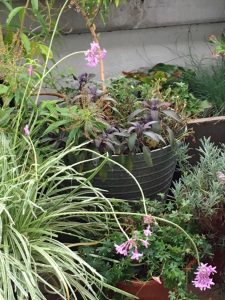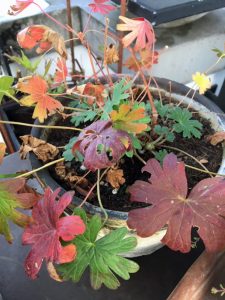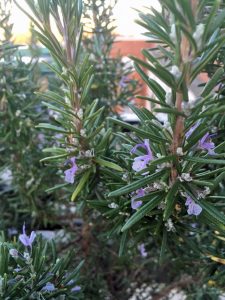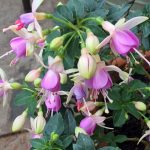Cold Comforts
Is it a forlorn hope that no further city edge developments will swallow up the few remaining, marginally viable, garden centres with a long history of horticultural wisdom and week-end pleasure? Christmas generally arives early for frequenters of these particular emporia as the October half term anticipates the arrival of tinselled and present-worthy offerings, often to the premature accompaniment of festive carols, while anything with horticultural pretensions is marginalised to make space. So I am very appreciative of the restraint shown by Sheen Garden Centre,which more or less confines its tinsel to one small room and gives colourful seasonal plants pride of place – cyclamen, ericas, hellebores, cotoneaster, hamamelis (always witch hazel to me) and much more.
Often bigger than you think, these largely outdoor suppliers take advantage of narrow gaps between buildings to store taller plants, and with ingenious use of levels make the most of every opportunity to invite interest in a wide range of more or less cultivated plants. It pays to search and rummage carefully.
Meanwhile, on the balcony the tulips and other bulbs have been planted, late, and crammed in where there is space. The result, I might fancifully anticipate, being not unlike the random, naturalistic planting favoured by the gardeners I admire, but adapted to this limited space, with bulbs scattered across various containers rather than through borders. Tulips, that most cultivated of bulbs, perhaps lend themselves least to notions of naturalisation but surprisingly benefit from this haphazard and casual approach in this particular high level planting area. Immaculate conceptions in regimented rows or groups, and sophisticated colour concepts, are an alternative but unrealistic prospect up aloft since I lack the necessary accompanying systematic mind or the will to vacate the appropriate pots.
The roof garden, balcony, terrace, name as you will, is remarkably small – not much more than 2m x 4m at its broadest point and host at any one time to upwards of an assorted seventy-two containers. I checked recently after a bit of a clearout. The  planters and containers range from long established partnerships with olives or roses, to seasonal associations with bulbs or plants. As always there are surprises, with some carefully chosen and possibly over nurtured plants promising to adapt to contained conditions being a conspicuous failure – mine or the plant’s I’m never sure. Various buddleias have been pre-eminently disappointing and possibly too dry, whereas the clematii of various sorts are often too vigorous in spite of their cramped and limited conditions.
planters and containers range from long established partnerships with olives or roses, to seasonal associations with bulbs or plants. As always there are surprises, with some carefully chosen and possibly over nurtured plants promising to adapt to contained conditions being a conspicuous failure – mine or the plant’s I’m never sure. Various buddleias have been pre-eminently disappointing and possibly too dry, whereas the clematii of various sorts are often too vigorous in spite of their cramped and limited conditions.
The tiled terrace is largely exposed to westerly winds and rain, alternating with southerly sun, as well as some protection from the neighbouring horse chestnuts, together with the olives, rosemary, and other robust boundary plants all around the balcony edge. The two Eucalyptus nichollii, are now both doing well and are particularly decorative, although too fragile and susceptible to wind to offer much shelter beyond a bit of shadow in the sultry, still weather of last summer. There is also shelter from the main building’s factory style roof which overhangs by a margin of two or three feet or the metric equivalent.
Lessons by Design
I’m not sure I’ve mentioned the roof very often as I tend to by-pass it’s industrial heritage, sitting functionally, atop the substantial red-brick building below. In addition to providing equally welcome or unwelcome rain protection, depending on the prevailing weather, it frequently creaks, disconcerting in high winds. In photos the roof is best avoided if at all possible as its apparently dense, solid structure is distracting, although appearances are deceptive and it is actually made of carefully constructed but ‘paper-thin’ steel and in close-up, in small quantities it has aged with a certain rustic charm. Hopefully not too weathered as replacing it is unimaginable since it comes in substantial sections without the portability of tiles and slates – so charm is welcome only in so far as it remains rain-proof.
On a late summer writing course many moons ago, I learnt two invaluable tips from a pre-eminent wordsmith – to always keep a note-book handy and to keep a ‘good line’ even when it was currently residing in a ‘bad verse’, as it might find its place another time. So too with planting schemes. And if you are lucky, even in my minimalistic space, for a moment the lines will work together and create something which can, in small measure, be more that its component parts before age, neglect, drought or unruly growth take over, but you have to be quick to notice.
Not forgetting that it is a truth universally acknowledged, that unexpected visitors never see your garden at its best.
I have also noticed how attuned we all are, unsurprisingly, to horticultural spaces that have some parallels with our own. I am particularly alert to ideas at the level of the single plant, and recently found it difficult to convince a visiting friend that the high rise eucalypti were happily adapted to life as ornamental species, and being confined to an air pot, were not going to grow much taller. His eye being better adapted to majestic tall trees in wide or wild spaces.
Last Lingerings
Remnants of Autumn remain down below and round about as a few tenacious last leaves cling on, but the relief from the incescent noise of leaf blowers is palpable now that they have largely done their job. Next year we are promised compost bins so  hopefully the effort required to transport and recycle the leaves off site will be scaled down, as they are added to the bins or even sacks for leafmold. I’m up for all of this but still worry about the energy required to power the leaf blowers.
hopefully the effort required to transport and recycle the leaves off site will be scaled down, as they are added to the bins or even sacks for leafmold. I’m up for all of this but still worry about the energy required to power the leaf blowers.
Metropolitan gardens are lucky if they can confer the serenity of country spaces and the traffic noise is more audible without the leaves, but there is nevertheless some compensation as the buildings and gardens around come into view, including the aforementioned church and majestic pines. Surprisingly, from this vantage point, as the days shorten and time spent lingering is rationed, paradoxically the sense of connection with the wider world expands, together with increased opportunities to gaze on the scene below.
A generally benign process.
From above it is easier to spot, and then rescue, footballs from next door lodged in out of reach bushes or drought affected trees unlikely to recover, miscreants dropping litter or new planting schemes coming into being. Pre-eminently a chance to be curious.
On the terrace, as Winter approaches salvias and roses flower on, pelargoniums enjoy the combination of wintry sun and background warmth and the hellebores and witch hazel are readying for their key-note display. The recently acquired dwarf wisteria looks settled and I am hopeful, too, that the replacement cherry will come through and thrive. With some trepidation I have followed instructions and cut the ever loyal lemon verbena down to size while waiting to be recompensed for care given, by the perfumed sweet smelling box – things look promising on that front but whether the scent will linger or be blown away I have yet to find out.
The anticipation alone has had its rewards so well worth being hopeful. Fortunate too for me that the increase in housing provision, with ever smaller gardens, has meant the arrival of more ‘dwarf varieties’ suitable for containers. Some flourish, others don’t and the wider implications of the building policies and horticultural developments are equally uncertain in the long run I might argue. But for the moment the pleasures are to be had and the insects and bird life can share in next year’s enjoyment.
Meanwhile I must resist the temptation to intervene. The combination of summer heat and my efforts at watering, together with periodic additions of seaweed extract (an odd choice perhaps for this native of southerly rather than maritime climes) has resulted in an abundance of olives, and healthy growth from all three trees. But down below, although over the garden fence, are two neat rows of struggling olive trees, set at right angles. Planted in narrow necked planters and kept perpetually in the rain shadow conferred both by the nearby building and their own canopies, the notion that Mediterranean plants tolerate dry conditions has taken hold, and they are suffering, which is a particular pity as the rest of the garden grows well.
I am feeling smug and also remembering the apt re-naming close family members were once encouraging, when it was agreed I might be better suited to being called Flora (Poste), the eponymous heroine of Cold Comfort Farm. Famed for taking Metropolitan ideas to the country, full of schemes to improve the lives of her relations, and always tempted to interfere in the affairs of others for sensible reasons, she is indeed an appealing role model for someone with my inclinations. Some forthcoming tree-work that necessitates cross border collaboration, might be an opportunity to offer advice supported by the photos on my ever-present phone, or even better to suggest that the advice to make use of a hosepipe and feed from time to time is passed on.
It is sometimes easier to pass on advice than to act on it, but I am really grateful for the plant suggestions and horticultural advice I’ve received though the comments and other messages over the last few months which are unexpected, helpful and informative and have mostly been put into practice. More would be welcome, particularly any experience of growing dwarf cherry trees in pots. I would offer guided tours in return but will have to settle for a wander through the photographic record instead.
And at 8.14 today, Tuesday 4th December, with the  wintry sun shining brightly, a queen bumble bee was milling around the rosemary which had caught my eye, proudly displaying its flowers and buds, presumably ready for next year’s early pollinators rather than this unexpected reluctant hibernator.
wintry sun shining brightly, a queen bumble bee was milling around the rosemary which had caught my eye, proudly displaying its flowers and buds, presumably ready for next year’s early pollinators rather than this unexpected reluctant hibernator.
In no particular order :
My tulbaghia collection is thriving and hopefully will again survive the winter
The echium on the allotment never reached it’s full height which may be a relief to neighbouring veg growers
After last year’s disappointment I lost confidence and didn’t plant any fritillaries this Autumn
But happily I do now have some wild marjoram
I need to choose taller dahlias for the allotment
I am hoping the willow herb will return
The permanent plants have grown up so the railings are now largely obscured
and the oak seedling may be happier in a hedgerow





I have a small leaved evergreen clematis which took a while to get going, but flowers beautifully now, and isn’t at all rampant. It’s called Oberon I think.
Do you make tea with the lemon verbena? I read somewhere that Mary Berry puts lemon verbena in her lemon drizzle cake.
It is lovely to be reminded of real gardening, rather than rambling and musing in an unnecessarily over-blown way (I now think having re-read my latest post) on gardening related themes increasingly distant from gardening itself.
I have checked – and as Clematis Oberon is highly perfumed, doesn’t require pruning and I have a vacant container I am planning to track one down – or at least I will once the tinsel has all been put away.
Hopefully it will soon be joining your other suggestions, including the sweetly scented box just outside the doors to the terrace, now well adapted to this warm and windy spot.
So thank you for another recommendation. I am also truly envious of the depth of your horticultural knowledge.